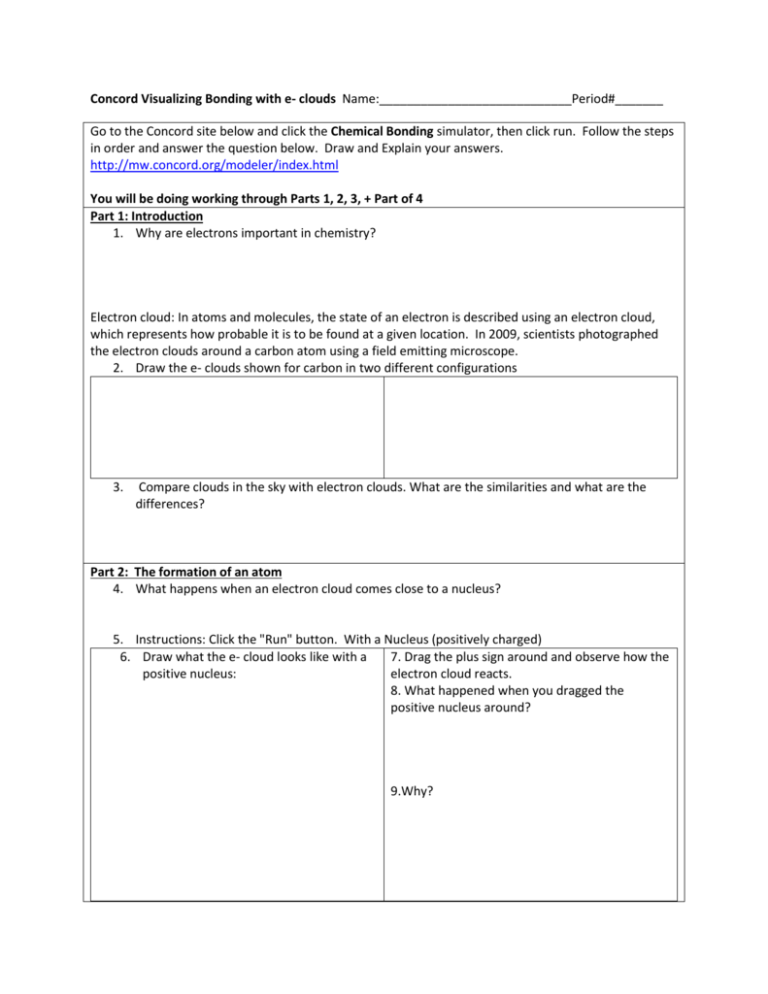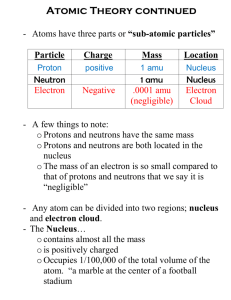Concord Visualizing Electron Clouds
advertisement

Concord Visualizing Bonding with e- clouds Name:____________________________Period#_______ Go to the Concord site below and click the Chemical Bonding simulator, then click run. Follow the steps in order and answer the question below. Draw and Explain your answers. http://mw.concord.org/modeler/index.html You will be doing working through Parts 1, 2, 3, + Part of 4 Part 1: Introduction 1. Why are electrons important in chemistry? Electron cloud: In atoms and molecules, the state of an electron is described using an electron cloud, which represents how probable it is to be found at a given location. In 2009, scientists photographed the electron clouds around a carbon atom using a field emitting microscope. 2. Draw the e- clouds shown for carbon in two different configurations 3. Compare clouds in the sky with electron clouds. What are the similarities and what are the differences? Part 2: The formation of an atom 4. What happens when an electron cloud comes close to a nucleus? 5. Instructions: Click the "Run" button. With a Nucleus (positively charged) 6. Draw what the e- cloud looks like with a 7. Drag the plus sign around and observe how the positive nucleus: electron cloud reacts. 8. What happened when you dragged the positive nucleus around? 9.Why? 10. Select "Neutron" and Click the "Run" button with a Neutron. 11. Draw what the e- cloud looks like with a 12.Drag the neutral nucleus around and observe neutral nucleus: how the electron cloud reacts. 13.What happened when your dragged the neutral nucleus around? 14.Why? 15. Select "Negative ion" and Click the "Run" button with a negative ion. 16.Draw what the e- cloud looks like with a 17. Drag the negative around and observe how negative ion: the electron cloud reacts. 18. What happened when you dragged the negative ion around? 19.Why? 20. Based on your observation of the behaviors of the electron cloud, explain why an electron cannot form an atom with only a neutron. Part 3 Chemical bonding 21. What happens when two atoms come together? The formation of a covalent bond 22. Instructions: Click the "Run" button and observe the change of the electron clouds. 23. Draw and describe what the e- clouds look like before and after you hit run Before After 24. Drag the "Interatomic distance" slider to make their distance shorter. Be sure to let the model run for a few seconds between each move. 25. Draw and describe what the e- clouds look like after you hit run at each of these distances: 0.04nm 0.05nm 0.1nm 26. Observe carefully how the electron clouds move. What is the distance at which the electron clouds start to merge? 27. What is the maximum distance between the two nuclei for a covalent bond to form?_________ 28. Draw and explain: Why can’t they get any farther apart and still bond? 29. What is the closest that they can get?______________ 30. Draw and explain: Why they can’t get any closer? Part 4. Chemical Polarity 31. What is chemical polarity and how does it relate to electron cloud? The polarity of a diatomic molecule 32. Instructions: Click the "Run" button and observe the movement of the electron clouds. 33. Draw and describe what the e- clouds look like before and after you hit run: Before After Draw and Explain what happened 34. Adjust the sliders so that the atoms' electronegativity’s are different and observe what happens. Repeat this for a number of different settings. 35. Draw and describe what the e- clouds look like after you hit run for each of these electronegativity’s: A=4 vs. B=1 A= 3 vs. B=2 A= 2 vs. B=2 Electronegativity Difference = Electronegativity Difference = Electronegativity Difference = Type of Bond Type of Bond Type of Bond 36. In the above models, what type of bond is formed when the difference of electronegativity between the two atoms is greater than 1? 37. How does the electron clouds behavior in questions 34-35 relate to our tug of war activity? Draw and explain:







